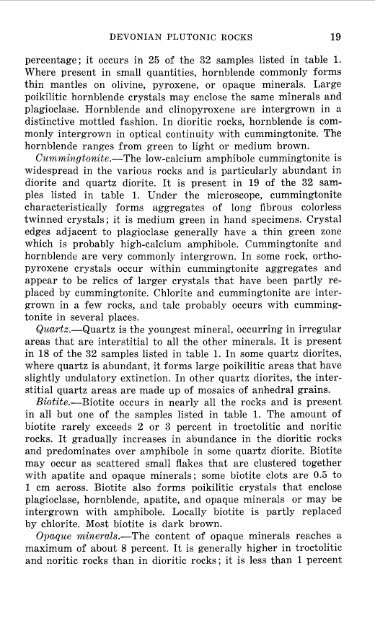Geology Of The Moxie Pluton In The Moosehead
Geology Of The Moxie Pluton In The Moosehead
Geology Of The Moxie Pluton In The Moosehead
Create successful ePaper yourself
Turn your PDF publications into a flip-book with our unique Google optimized e-Paper software.
DEVONIAN PLUTONIC ROCKS 19<br />
percentage; it occurs in 25 of the 32 samples listed in table 1.<br />
Where present in small quantities, hornblende con1monly forms<br />
thin mantles on olivine, pyroxene, or opaque minerals. Large<br />
poikilitic hornblende crystals may enclose the same minerals and<br />
plagioclase. Hornblende and clinopyroxene are intergrown in a<br />
distinctive mottled fashion. <strong>In</strong> dioritic rocks, hornblende is commonly<br />
intergrown in optical continuity with cummingtonite. <strong>The</strong><br />
hornblende ranges from green to light or medium brown.<br />
Cummingtonite.-<strong>The</strong> low-calcium amphibole cummingtonite is<br />
widespread in the various rocks and is particularly abundant in<br />
diorite and quartz diorite. It is present in 19 of the 32 samples<br />
listed in table 1. Under the microscope, cummingtonite<br />
characteristically forms aggregates of long fibrous colorless<br />
twinned crystals; it is medium green in hand specimens. Crystal<br />
edges adjacent to plagioclase generally have a thin green zone<br />
which is probably high-calcium amphibole. Cummingtonite and<br />
hornblende are very commonly intergrown. <strong>In</strong> some rock, orthopyroxene<br />
crystals occur within cummingtonite aggregates and<br />
appear to be relics of larger crystals that have been partly replaced<br />
by cummingtonite. Chlorite and cummingtonite are intergrown<br />
in a few rocks, and talc probably occurs with cummingtonite<br />
in several places.<br />
Quartz.-Quartz is the youngest mineral, occurring in irregular<br />
areas that are interstitial to all the other minerals. It is present<br />
in 18 of the 32 samples listed in table 1. <strong>In</strong> some quartz diorites,<br />
where quartz is abundant, it forms large poikilitic areas that have<br />
slightly undulatory extinction. <strong>In</strong> other quartz diorites, the interstitial<br />
quartz areas are made up of mosaics of anhedral grains.<br />
Biotite.-Biotite occurs in nearly all the rocks and is present<br />
in all but one of the samples listed in table 1. <strong>The</strong> amount of<br />
biotite rarely exceeds 2 or 3 percent in troctolitic and noritic<br />
rocks. It gradually increases in abundance in the dioritic rocks<br />
and predominates over amphibole in some quartz diorite. Biotite<br />
may occur as scattered small flakes that are clustered together<br />
with apatite and opaque minerals; some biotite clots are 0.5 to<br />
1 em across. Biotite also forms poikilitic crystals that enclose<br />
plagioclase, hornblende, apatite, and opaque minerals or may be<br />
intergrown with amphibole. Locally biotite is partly replaced<br />
by chlorite. Most biotite is dark brown.<br />
Opaque minerals.-<strong>The</strong> content of opaque minerals reaches a<br />
maximum of about 8 percent. It is generally higher in troctolitic<br />
and noritic rocks than in dioritic rocks ; it is less than 1 percent

















